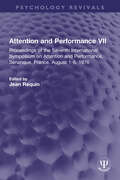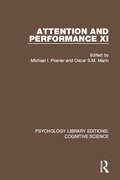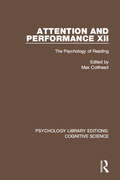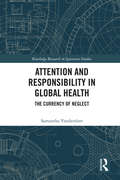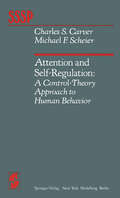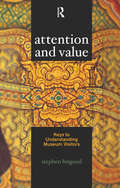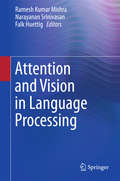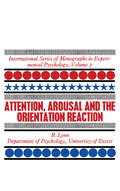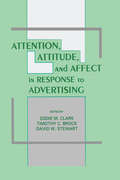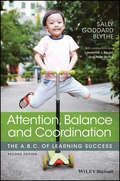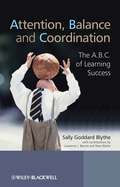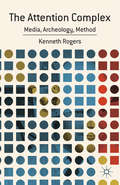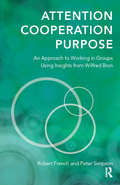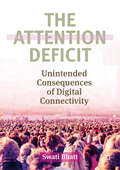- Table View
- List View
Attention and Performance VII: Proceedings of the Seventh International Symposium on Attention and Performance, Senanque, France, August 1-6, 1976 (Psychology Revivals)
by Jean RequinOriginally published in 1978, this seventh volume of an international series continues the objective to increase and disseminate scientific knowledge in the area of human attention, performance and information processing, and to foster international communication in this area. This volume covers the following topics: time in perception; word perception and reading; speech perception and coding; hemisphere differences; response and physiological processes; theories and models. Today it can be read and enjoyed in its historical context.
Attention and Performance VII: Proceedings of the Seventh International Symposium on Attention and Performance, Senanque, France, August 1-6, 1976 (Psychology Revivals)
by Jean RequinOriginally published in 1978, this seventh volume of an international series continues the objective to increase and disseminate scientific knowledge in the area of human attention, performance and information processing, and to foster international communication in this area. This volume covers the following topics: time in perception; word perception and reading; speech perception and coding; hemisphere differences; response and physiological processes; theories and models. Today it can be read and enjoyed in its historical context.
Attention and Performance XI (Psychology Library Editions: Cognitive Science)
by Michael I. Posner Oscar S. M. MarinOriginally published in 1985, this volume presents the proceedings of the 11th International Symposium on Attention and Performance. With few exceptions, the central emphasis in previous meetings of the Attention and Performance Association was on the information-processing approach to normal human cognition. This emphasis had been supplemented, on occasion, by studies employing EEG methods, but there had not been systematic attempts to relate the information-processing approach to work in the neurosciences. This volume seeks to emphasize the search for mechanism with such methods of approach as the following: anatomical, physiological, neuropsychological, behavioral, and computational. The editors believed that this was in accord with recent developing trends in cognition and particularly with developments in the study of attention at the time.
Attention and Performance XI (Psychology Library Editions: Cognitive Science)
by Michael I. Posner Oscar S.M. MarinOriginally published in 1985, this volume presents the proceedings of the 11th International Symposium on Attention and Performance. With few exceptions, the central emphasis in previous meetings of the Attention and Performance Association was on the information-processing approach to normal human cognition. This emphasis had been supplemented, on occasion, by studies employing EEG methods, but there had not been systematic attempts to relate the information-processing approach to work in the neurosciences. This volume seeks to emphasize the search for mechanism with such methods of approach as the following: anatomical, physiological, neuropsychological, behavioral, and computational. The editors believed that this was in accord with recent developing trends in cognition and particularly with developments in the study of attention at the time.
Attention and Performance XII: The Psychology of Reading (Psychology Library Editions: Cognitive Science)
by Max ColtheartOriginally published in 1987 this volume presented a comprehensive state-of-the-art account of what was known about the psychology of reading at the time. All the fundamental aspects of reading are considered: visual attention, visual feature analysis, visual masking, letter and word recognition, priming effects, eye movements in reading, phonological processing, working memory and reading, parsing, sentence comprehension, and text integration. The subject of reading is approached from a variety of different theoretical perspectives, including cognitive psychology, connectionism, neuropsychology and linguistics. This broad and comprehensive review will still be of value for undergraduate and graduate teaching as well as research workers engaged in experimental or theoretical investigations of any aspect of the psychology of reading.
Attention and Performance XII: The Psychology of Reading (Psychology Library Editions: Cognitive Science)
by Max ColtheartOriginally published in 1987 this volume presented a comprehensive state-of-the-art account of what was known about the psychology of reading at the time. All the fundamental aspects of reading are considered: visual attention, visual feature analysis, visual masking, letter and word recognition, priming effects, eye movements in reading, phonological processing, working memory and reading, parsing, sentence comprehension, and text integration. The subject of reading is approached from a variety of different theoretical perspectives, including cognitive psychology, connectionism, neuropsychology and linguistics. This broad and comprehensive review will still be of value for undergraduate and graduate teaching as well as research workers engaged in experimental or theoretical investigations of any aspect of the psychology of reading.
Attention and Performance Xiii: Motor Representation and Control (Attention and Performance Series)
by M. JeannerodCompiled as a result of the Thirteenth Symposium of the Association for Attention and Performance, this collection focuses on the Symposium's theme: Organization of Action. The book is arranged in sections which provide a comprehensive view of the main issues raised during the meeting. Several aspects of the theme were considered, including: the anatomical and physiological constraints on motor preparation and execution . the influence of control (proprioceptive, cutaneous, visual, oculomotor) signals the contribution of kinematics to the understanding of the underlying mechanisms and the role of cognitive constraints such as attention or learning in goal selection This new volume is of particular interest to professionals and researchers in cognitive psychology, physiology, and neuropsychology as well as those studying motor skills.
Attention and Performance Xiii: Motor Representation and Control (Attention and Performance Series)
by Marc JeannerodCompiled as a result of the Thirteenth Symposium of the Association for Attention and Performance, this collection focuses on the Symposium's theme: Organization of Action. The book is arranged in sections which provide a comprehensive view of the main issues raised during the meeting. Several aspects of the theme were considered, including: the anatomical and physiological constraints on motor preparation and execution . the influence of control (proprioceptive, cutaneous, visual, oculomotor) signals the contribution of kinematics to the understanding of the underlying mechanisms and the role of cognitive constraints such as attention or learning in goal selection This new volume is of particular interest to professionals and researchers in cognitive psychology, physiology, and neuropsychology as well as those studying motor skills.
Attention and Responsibility in Global Health: The Currency of Neglect (Routledge Research in Ignorance Studies)
by Samantha VanderslottAttention and Responsibility in Global Health shows the construction of health through what is neglected and how the label of neglect is used, to make the case that shift in attitudes towards tropical diseases is based on changing cultures of health and disease. Tropical diseases have moved from being of high importance for European empires to being neglected and unknown, and then returning to the spotlight once again. During this process, the understanding, framing and overall character of the disease grouping has changed through a rediscovery of a health issue once rendered neglectable. The book depicts this change in relevance of tropical diseases from colonial history to the present day diseases across political, cultural, and socio-economic contexts. It shows the transformation of tropical diseases as a grouping that uncovers the changing strategies, tactics and unintended consequences used in advocacy campaigning by scientists, NGOs and policymakers to drive disease issues up the policy agenda. Drawing on the emergent field of ignorance studies, the book explores ideas about the uses and deployment of strategic "not knowing". It is aimed at academics and students in science and technology studies, the sociology of health and medicine, environmental sociology, public policy, and the history of science.
Attention and Responsibility in Global Health: The Currency of Neglect (Routledge Research in Ignorance Studies)
by Samantha VanderslottAttention and Responsibility in Global Health shows the construction of health through what is neglected and how the label of neglect is used, to make the case that shift in attitudes towards tropical diseases is based on changing cultures of health and disease. Tropical diseases have moved from being of high importance for European empires to being neglected and unknown, and then returning to the spotlight once again. During this process, the understanding, framing and overall character of the disease grouping has changed through a rediscovery of a health issue once rendered neglectable. The book depicts this change in relevance of tropical diseases from colonial history to the present day diseases across political, cultural, and socio-economic contexts. It shows the transformation of tropical diseases as a grouping that uncovers the changing strategies, tactics and unintended consequences used in advocacy campaigning by scientists, NGOs and policymakers to drive disease issues up the policy agenda. Drawing on the emergent field of ignorance studies, the book explores ideas about the uses and deployment of strategic "not knowing". It is aimed at academics and students in science and technology studies, the sociology of health and medicine, environmental sociology, public policy, and the history of science.
Attention and Self-Regulation: A Control-Theory Approach to Human Behavior (Springer Series in Social Psychology)
by C. S. Carver M. F. Scheier"Seek simplicity and distrust it. " Alfred North Whitehead "It will become all too clear that an ability to see patterns in behavior, an ability that some might feel proud of, can lead more easily to a wrong description than a right one. " William T. Powers The goal of the theorist-the scholar-is to take a collection of observations of the world, and perceive order in them. This process necessarily imposes an artificial simplicity upon those observations. That is, specific observations are weighed differently from each other whenever a theoretical account is abstracted from raw experiences. Some observed events are misunderstood or distorted, others are seen as representing random fluctuations and are ignored, and yet others are viewed as centrally important. This abstraction and oversimplification of reality is inevitable in theory construction. Moreover, the abstracted vision builds upon itself. That is, as a structure begins to emerge from continued observation, the structure itself guides the search for new information. The result is a construction that is more elaborate than what existed before, but it still is usually simpler than reality. It is important for scholars to believe in the value of their task, and in the general correctness of the vision that guides their work. This commitment, and the hope of progress that follows from it, make it possible to continue even when the work is difficult and slow.
Attention and Value: Keys to Understanding Museum Visitors
by Stephen BitgoodHow can museums capture visitors’ attention? And how can their attention be sustained? In this important volume, leading visitor researcher and educational psychologist Stephen Bitgood proposes a model—the attention-value model—that will help museum practitioners create more effective museum environments. A major advance beyond earlier efforts, the attention-value model shows how both personal and exhibit design variables influence the capture, focus, and engagement of attention. Bitgood also offers extensive background in the visitor attention literature, details of his extensive testing of the attention-value tool, and guidelines for its application. Balancing theory, research, and practical application, Attention and Value is a must-read for exhibition developers at all levels—from students to seasoned practitioners.
Attention and Value: Keys to Understanding Museum Visitors
by Stephen BitgoodHow can museums capture visitors’ attention? And how can their attention be sustained? In this important volume, leading visitor researcher and educational psychologist Stephen Bitgood proposes a model—the attention-value model—that will help museum practitioners create more effective museum environments. A major advance beyond earlier efforts, the attention-value model shows how both personal and exhibit design variables influence the capture, focus, and engagement of attention. Bitgood also offers extensive background in the visitor attention literature, details of his extensive testing of the attention-value tool, and guidelines for its application. Balancing theory, research, and practical application, Attention and Value is a must-read for exhibition developers at all levels—from students to seasoned practitioners.
Attention and Vision in Language Processing
by Ramesh Kumar Mishra Narayanan Srinivasan Falk HuettigThis volume provides a comprehensive overview of the nature of attentional and visual processes involved in language comprehension. Key concerns include how linguistic and non-linguistic processes jointly determine language comprehension and production and how the linguistic system interfaces with perceptual systems and attention. Language scientists have traditionally considered language in isolation from other cognitive and perceptual systems such as attention, vision and memory. In recent years, however, it has become increasingly clear that language comprehension must be studied within interaction contexts. The study of multimodal interactions and attentional processes during language processing has thus become an important theoretical focus that guides many research programs in psycholinguistics and related fields.
Attention, Arousal and the Orientation Reaction: International Series of Monographs in Experimental Psychology
by R. LynnAttention, Arousal and the Orientation Reaction aims to present in a volume the works of Pavlov, an eminent Russian physiologist known for his contributions, specifically the classical conditioning. This book contains the interpretations and theories in physiological terms, and elaborates on the neurological models of significant interest. The “orientation reaction†is described, and the Sokolov's model, which is claimed to be the most comprehensive model for the orientation reaction, is then illustrated. This text also explains the phenomenon of habituation, wherein facts involved are summarized in a chapter. A discussion on the numerous neurological models of the habituation process is then given. This text notes that the models are divided into ""one-stage models"" and ""two-stage models."" Other topics presented are the effects of transforming a neutral stimulus into a conditioned stimulus; the orientation reaction in ontogenetic and phylogenetic development; and the orientation reaction in the measurement of individual differences. This book will be beneficial to those fascinated with the works of Pavlov, especially the psychology students and practitioners.
Attention, Attitude, and Affect in Response To Advertising
by Eddie M. Clark Timothy C. Brock David W. StewartLinked from the days of their origins, psychology and advertising developed as independent disciplines at almost the same time in the late nineteenth century. Providing an important arena in which psychologists have tested methods and theories, advertising has been a stimulus for research and development in such diverse specialties as learning and behavioral decision theory, psychometrics, perception, and social and mathematical psychology. Psychology, in turn, has contributed a wide assortment of tools, theories, and techniques to the practice of advertising. These contributions have found their place in virtually all areas of advertising practice -- stimulating creativity, evaluating the creative product, and informing the scheduling of media. Purposely eclectic, this volume presents new issues in consumer psychology and advertising such as the relationship between gender differences, cortical organization and advertising; new approaches to old issues such as attention as an epiphenomenon, and meta-analysis of comparative advertising research; and new applications of consumer psychology to other fields such as examining health behavior as consumer behavior, affect and political advertising, and the relationship between advertising and eating disorders. This volume is the result of the Sixth Annual Advertising and Consumer Behavior Conference, which was designed to bring together researchers and practitioners from both psychology and advertising. Chapter contributions are made by professionals in advertising and marketing, professors in psychology and marketing departments, and psychologists who consult for advertising and marketing organizations. Thus, the chapters represent a microcosm of the type of interaction that has characterized the interface of psychology and advertising for more than a hundred years.
Attention, Attitude, and Affect in Response To Advertising
by Eddie M. Clark Timothy C. Brock David W. StewartLinked from the days of their origins, psychology and advertising developed as independent disciplines at almost the same time in the late nineteenth century. Providing an important arena in which psychologists have tested methods and theories, advertising has been a stimulus for research and development in such diverse specialties as learning and behavioral decision theory, psychometrics, perception, and social and mathematical psychology. Psychology, in turn, has contributed a wide assortment of tools, theories, and techniques to the practice of advertising. These contributions have found their place in virtually all areas of advertising practice -- stimulating creativity, evaluating the creative product, and informing the scheduling of media. Purposely eclectic, this volume presents new issues in consumer psychology and advertising such as the relationship between gender differences, cortical organization and advertising; new approaches to old issues such as attention as an epiphenomenon, and meta-analysis of comparative advertising research; and new applications of consumer psychology to other fields such as examining health behavior as consumer behavior, affect and political advertising, and the relationship between advertising and eating disorders. This volume is the result of the Sixth Annual Advertising and Consumer Behavior Conference, which was designed to bring together researchers and practitioners from both psychology and advertising. Chapter contributions are made by professionals in advertising and marketing, professors in psychology and marketing departments, and psychologists who consult for advertising and marketing organizations. Thus, the chapters represent a microcosm of the type of interaction that has characterized the interface of psychology and advertising for more than a hundred years.
Attention, Balance and Coordination: The A.B.C. of Learning Success
by Sally Goddard BlytheAn updated edition of the definitive handbook on the physical basis for learning for professionals involved in education and child development, written by the respected author of acclaimed titles in the field. A comprehensive overview of the relationship between neuromotor maturity and physical development on learning outcomes and behaviour in childhood and later life Explores why early reflexes are important, their functions in early development, their effects on learning and behavior if retained, and the possible effects on other aspects of development Brings together a specialist body of knowledge and makes it accessible to anyone involved in treating the symptoms of specific learning difficulties and emotional problems. Includes new information on the role of the vestibular system in anxiety and agoraphobia, a new chapter of case studies, and an Epilogue placing the INPP Method in a broader scientific context
Attention, Balance and Coordination: The A.B.C. of Learning Success
by Sally Goddard BlytheAttention, Balance and Coordination is the most up-to-date handbook for professionals involved in education and child development, providing a new understanding of the source of specific behavioural problems. Written by a respected author of acclaimed titles in this field Explains why early reflexes are important, their functions in development and their effects on learning, behaviour and beyond - also covers adult neurological dysfunctions anxiety and agoraphobia Builds on an ABC of Attention, Balance and Coordination to create a unique look across specific learning difficulties, linked by common motor skills challenges resulting from neuro-developmental deficiencies Includes the INPP Developmental Screening Questionnaire together with guidance on how to use and interpret it
Attention, Balance and Coordination: The A.B.C. of Learning Success
by Sally Goddard BlytheAn updated edition of the definitive handbook on the physical basis for learning for professionals involved in education and child development, written by the respected author of acclaimed titles in the field. A comprehensive overview of the relationship between neuromotor maturity and physical development on learning outcomes and behaviour in childhood and later life Explores why early reflexes are important, their functions in early development, their effects on learning and behavior if retained, and the possible effects on other aspects of development Brings together a specialist body of knowledge and makes it accessible to anyone involved in treating the symptoms of specific learning difficulties and emotional problems. Includes new information on the role of the vestibular system in anxiety and agoraphobia, a new chapter of case studies, and an Epilogue placing the INPP Method in a broader scientific context
Attention, Balance and Coordination: The A.B.C. of Learning Success
by Sally Goddard BlytheAttention, Balance and Coordination is the most up-to-date handbook for professionals involved in education and child development, providing a new understanding of the source of specific behavioural problems. Written by a respected author of acclaimed titles in this field Explains why early reflexes are important, their functions in development and their effects on learning, behaviour and beyond - also covers adult neurological dysfunctions anxiety and agoraphobia Builds on an ABC of Attention, Balance and Coordination to create a unique look across specific learning difficulties, linked by common motor skills challenges resulting from neuro-developmental deficiencies Includes the INPP Developmental Screening Questionnaire together with guidance on how to use and interpret it
The Attention Complex: Media, Archeology, Method
by K. RogersOver the past two decades in the United States, a profound reorientation of human attention has taken shape. This book addresses the recent cultural anxiety about attention as a way of negotiating a crisis of the self that is increasingly managed, mediated, and controlled by technologies.
Attention, Cooperation, Purpose: An Approach to Working in Groups Using Insights from Wilfred Bion
by Robert French Peter SimpsonThis book describes an approach based on attention that can help individuals and groups to cooperate more effectively. It presents the first book-length reassessment of Wilfred Bion's ideas on groups. Every group has a purpose or purposes - or, as Bion put it, "every group, however casual, meets to 'do' something." The approach described here shows how individual group members' use of attention - both broad or "evenly suspended" and focused - can promote a better understanding of purpose, making it possible for them to do what they have met to do. This work of attention enables group members to maintain a clear sense of their purpose and also to recognise how easily they can become distracted, losing focus and dispersing their energies into activities that are off task. The approach builds on the authors' experience of using Bion's insights into group dynamics over twenty-five years in different contexts, formal and informal, as group members, managers, leaders, teachers, consultants, researchers, family members, and friends.
Attention, Cooperation, Purpose: An Approach to Working in Groups Using Insights from Wilfred Bion
by Robert French Peter SimpsonThis book describes an approach based on attention that can help individuals and groups to cooperate more effectively. It presents the first book-length reassessment of Wilfred Bion's ideas on groups. Every group has a purpose or purposes - or, as Bion put it, "every group, however casual, meets to 'do' something." The approach described here shows how individual group members' use of attention - both broad or "evenly suspended" and focused - can promote a better understanding of purpose, making it possible for them to do what they have met to do. This work of attention enables group members to maintain a clear sense of their purpose and also to recognise how easily they can become distracted, losing focus and dispersing their energies into activities that are off task. The approach builds on the authors' experience of using Bion's insights into group dynamics over twenty-five years in different contexts, formal and informal, as group members, managers, leaders, teachers, consultants, researchers, family members, and friends.
The Attention Deficit: Unintended Consequences of Digital Connectivity
by Swati BhattDigital technology has enabled connectivity on an unimagined scale. Human beings are social animals and economic activity promotes this socialization. Market transactions are based on optimism about the future, faith that the world is good and trust that growth is organic or coming from within the system. Individuals therefore invest in the future by having children, by extending credit and accepting risk, and by building connections with others in the sincere expectation of this connectivity being reciprocated. This book explores the unintended consequences of ubiquitous connectivity. The first effect is captured by the sharing model. Technology offers multiple avenues for sharing experiences and personal information, so active engagement with this increased content uses mental effort. Connection inevitably leads to comparisons with other groups and individuals, so despite the benefits of affirmation and group inclusion, these links corrode social networks, leading to depression and mental apathy. The second effect--the result of the commercialization of sharing--is encapsulated in the attention deficit model. Loss of self-worth, driven by the first effect, encourages further connectivity and sharing as buyers seek more comfort and reassurance via social media, paying with time and personal information. The product is digital content and the payment is with time and data. Correspondingly, social media fulfills this demand with exuberance, both via user-generated content and commercially curated content. We are overwhelmed with even more information, paying with increasingly scarce time and attention. Finally, the third and most consequential effect is diminished risk taking. Attention scarcity, as a consequence of the content tsunami, throttles cognitive effort, impairing judgment and decision-making. So the safe bet may be to do nothing . . . take no risks and no gambles. Weaving together the latest research on economics, psychology, and neuroscience, this book fills a void for readers wanting a smart, clear analysis of communications markets and the commercialization of Internet-inspired connectivity.
